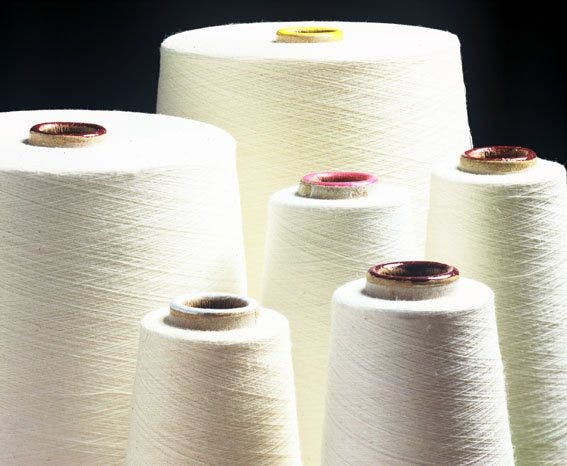India-Vietnam yarn trade weaving a stronger textile future

As global trade dynamics evolve under the pressures of changing policies and geopolitical uncertainties, two of Asia's textile powerhouses—India and Vietnam—are strategically aligning to enhance cooperation in the garment and textile sector. At the heart of this collaboration lies the yarn trade, a crucial component in both nations' ambitions to fortify supply chains and tap into new markets.
Complementary strengths, yarn as the linchpin
Vietnam’s textile and garment sector, which recorded an estimated $44 billion in exports in 2024, relies heavily on imports for its raw materials. Currently, over 65 per cent of these inputs are sourced from China. However, as Vietnam seeks to diversify and reduce dependency, India emerges as a natural and advantageous partner—especially in the yarn segment.
India, home to a robust and diverse textile ecosystem, is one of the world's leading producers of cotton and yarn. In 2024, India exported over $173 million worth of yarn to Vietnam, marking a significant growth from $151 million in 2023. This upward trajectory underscores Vietnam's increasing appetite for Indian yarn and India’s capability to meet that demand.
"The synergy between Vietnam's manufacturing prowess and India's raw material abundance is undeniable," says Bùi Trung Thướng, Trade Counselor at the Vietnam Trade Office in India. This synergy, Thướng emphasizes, can be amplified through mechanisms like the ASEAN-India Free Trade Agreement (AIFTA), which significantly reduces tariffs on yarn and other key textile products.
Yarn trade trends
Recent trade data reinforces the growing synergy. Between 2022 and 2024, Indian yarn exports to Vietnam rose from $118 million to $173 million. During the same period, Vietnam’s yarn exports to India declined sharply, from $82 million to $55 million—further highlighting India's growing role as a primary supplier.
This trend points to a structural shift. As Vietnam repositions itself as a global garment leader, it is increasingly reliant on Indian yarn to feed its booming manufacturing sector. Meanwhile, India benefits from a reliable export market for its surplus yarn production, supporting its domestic spinning industry and rural economies dependent on cotton farming.
Meanwhile, India's high demand for premium polyester fabric, estimated at $1.2 billion annually, presents a significant opportunity for Vietnam. By leveraging their respective strengths, both nations can create efficient two-way supply chains. Also the need to diversify markets due to the US tariff, increases both countries need to increase the trade between themselves, to strengthen their own markets.
Unlocking trade through regional cooperation
The recent implementation of the US reciprocal tax policy has made it imperative for Vietnam and India to look inward and reinforce regional trade links. Thướng proposes the establishment of a $500 million Joint Investment Fund aimed at setting up spinning mills in southern India and northern Vietnam. These facilities will be instrumental in processing yarn and other raw materials, ensuring a smoother, more efficient supply chain.
Further, a proposed bilateral preferential tax agreement could reduce import-export costs, boosting competitiveness. These initiatives, particularly in the yarn trade, can offer stability and growth at a time when global trade is fraught with uncertainty.
Vietnam also stands to benefit from importing Indian shuttleless looms—30–40 per cent cheaper than their European counterparts—enhancing its capacity to process Indian yarn into high-quality fabric and garments.
Table: India-Vietnam textile import and export
|
Year (Jan-Nov) |
Category |
India exports to Vietnam |
India imports from Vietnam |
Notes |
|
2022 |
Total Textile Trade |
333.884 |
302.204 |
Overall trade volume. |
|
Yarn |
118.367 |
82.907 |
Increasing Indian yarn exports. |
|
|
Fabric |
77.928 |
106.976 |
Vietnam fabric export to India higher than India's to Vietnam. |
|
|
Fibre |
137.589 |
112.32 |
High volume of fiber trade. |
|
|
2023 |
Total Textile Trade |
327.282 |
247.306 |
Trade values fluctuated. |
|
Yarn |
151.578 |
74.298 |
Continued yarn export growth. |
|
|
Fabric |
71.198 |
75.865 |
Fabric trade remained relatively stable. |
|
|
Fibre |
104.505 |
97.143 |
Fiber trade remained high. |
|
|
2024 |
Total Textile Trade |
404.446 |
212.76 |
Indian textile export values are greater than import values. |
|
Yarn |
173.408 |
55.908 |
Strong growth in yarn exports. |
|
|
Fabric |
67.319 |
76.984 |
Fabric trade remained similar to the previous year. |
|
|
Fibre |
163.719 |
79.866 |
Increased fiber export from India. |
Projected growth areas
Yarn and fibers: India's exports of cotton yarn and synthetic fibers are expected to see the most substantial growth. With increased Vietnamese demand, these exports could potentially rise by 20-30 per cent over the next 3-5 years.
Fabrics: Trade in fabrics, particularly high-quality polyester fabrics, will also increase. Growth in this sector could be around 15-20 per cent as Vietnam diversifies its fabric sourcing.
Machinery and Technology: Exports of Indian textile machinery to Vietnam are projected to see significant growth. This sector could witness a 25-30 per cent increase as Vietnam modernizes its production facilities.
Finished Goods: As Vietnam increases its manufacturing efficiency, there is a possibility of a rise in finished garment exports to India. This growth is harder to pinpoint, but could rise by 10-15 per cent over the coming years.
What the future holds
With policy support and joint ventures, the yarn trade between India and Vietnam is poised for exponential growth. Experts project a 20-30 per cent increase in India’s yarn exports to Vietnam over the next 3–5 years. This growth will be led by:
- Greater optimization of AIFTA tariff reductions.
- Investments in spinning infrastructure.
- Diversification away from Chinese suppliers.
- Growing demand for Indian cotton and synthetic yarns.
Moreover, as Vietnam boosts its garment production for global markets, its demand for reliable, high-quality yarn will only intensify, securing India's place as a preferred supplier.
